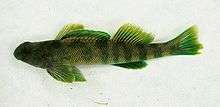Greenside darter
The greenside darter (Etheostoma blennioides) is a species of fish in the family Percidae. It inhabits swift riffles in the eastern United States and southern Ontario.[1]
| Greenside darter | |
|---|---|
 | |
| Scientific classification | |
| Kingdom: | |
| Phylum: | |
| Class: | |
| Order: | |
| Family: | |
| Genus: | |
| Subgenus: | Etheostoma |
| Species: | E. blennioides |
| Binomial name | |
| Etheostoma blennioides Rafinesque, 1819 | |
| Synonyms | |
| |
Biology
Greenside darters typically live for three to five years, grow to a maximum of 132 mm standard length and sexually mature at one to two years of age. Greenside darters are reproductively active from February to April in the Midwest and Southeastern United States. Spawning occurs over algae- or moss-covered rocks in deep, swift riffles that are guarded by males that vigorously defended against intruders. Females linger in pools below the riffle and move into a male's territory when ready to spawn. Eggs are viscous and stick together in small clumps on green algae (Cladophora), moss (Fontinalis), and riverweed (Podostemaceae). E. blennioides is insectivorous, with analyzed gut contents containing Nematocera larvae, more specifically black fly and midge (Chironomidae) larvae. Significant numbers of mayfly (Ephemeroptera) and caddisfly (Trichoptera) nymphs were also found.
Characteristics
The greenside darters have an elongated body with a long and rounded snout. The dorsum is greenish-brown, with six or seven dark quadrate saddles and the sides with five to eight dark green, typically U- or W-shaped blotches. The nape, cheeks, opercle, and belly are completely scaled, with the breast naked. The anal fin has six to 10 rays (usually eight) and 13-16 pectoral fin rays, and both are bright green in breeding males; caudal fins are yellowish to clear; dorsal fin rays number 12-15, with red basal bands; breeding males have intensely bluish-green nasal and oral areas and sometimes black on the head.[2]
Conservation
E. blennioides is currently secure throughout its range, except in Mississippi, where its habitat was altered by the Tennessee-Tombigbee Waterway.
Distribution
The E. blennioides subspecies are believed to have diverged in separate drainage systems and glacial refugia during the Pleistocene ice ages,[3] which destroyed older connections and shaped new river systems.[4]
- E. b. blennioides (northern greenside darter) ranges throughout the Ohio River basin and northeast into the Potomac and upper Genesee Rivers.
- E. b. newmanii (highlands greenside darter) occurs in the Cumberland and Tennessee River drainages of Alabama, Kentucky, and Tennessee; it also occurs in the Arkansas, Ouachita, St. Francis, and White Rivers of Arkansas and Missouri.
- E. b. pholidotum (central greenside darter) occurs in north-flowing rivers of the northern Ozarks, the Wabash basin, the Maumee River drainage, and along the shores of Lake Erie and Lake Ontario.
Etymology
- Etheostoma: etheo meaning filter or strain and stoma meaning mouth
- E. b. blennioides: referring to its resemblance to the Mediterranean blennies Constantine S. Rafinesque knew in his early years
- E. b. newmanii: patronymic for Francis H. Newman, aquatic biologist, who collected the type specimen
- E. b. pholidotum: meaning scaled, referring to its fully scaled belly.[5]
Habitat
Greenside darters inhabit gravel riffles of large creeks to medium rivers and often are found in swift waters over large boulders and large rubble.[6]
Systematics
As previously stated, Miller (1968) concluded the E. blennioides complex consists of the four subspecies above.[7] Unpublished studies by Richard L. Mayden and colleagues indicate E. b. newmanii from the Cumberland and Tennessee Rivers may be a valid species and distinct from other members of the complex.[8] The former subspecies, E. b. gustelli has recently been re-elevated to species status, Etheostoma gustelii (Tuckasegee darter) based on lack of hybridization.
Etheostoma blennioides belongs to the subgenus Etheostoma that contains these species:
- E. blennius (blenny darter)
- E. gutselli (Tuckasegee darter)
- E. histrio (harlequin darter)
- E. inscriptum (turquoise darter)
- E. lynceum (brighteye darter)
- E. rupestre (rock darter)
- E. sellare (Maryland darter)
- E. swannanoa (Swannanoa darter)
- E. thalassinum (seagreen darter)
- E. zonale (banded darter)
Etheostoma blennioides is further nested within the greenside darter group that contains E. blennius, E. gutselli, E. inscriptum, E. swannanoa, and E. thalassinum.[9]
References
- NatureServe (2013). "Etheostoma blennioides". The IUCN Red List of Threatened Species. IUCN. 2013: e.T202453A2745023. doi:10.2305/IUCN.UK.2013-1.RLTS.T202453A2745023.en. Retrieved 14 January 2018.
- Boschung, Herbert T; Mayden, Richard L; Tomelleri, Joseph R (2004). The Fishes of Alabama. Smithsonian Books.
- Miller, R.V. (1968). A systematic study of the Greenside darter, Etheostoma blennioides Rafinesquei (Pisces: Percidae). Copeia 1968: pp. 1-40.
- Dyke, A.S. and Prest, V.K. (1987). Late Wisconsin and Holocene history of the Laurentide Ice Sheet. Geogr. Phys. Quatern. 41: pp. 237-263.
- Scharpf, Christopher (2008). North American Native Fishes Association: American Currents 34(4): pp. 20-26.
- Boschung, Herbert T; Mayden, Richard L; Tomelleri, Joseph R (2004). The Fishes of Alabama. Smithsonian Books.
- Miller, R.V. (1968). A systematic study of the Greenside darter, Etheostoma blennioides Rafinesquei (Pisces: Percidae). Copeia 1968: pp. 1-40.
- Boschung, Herbert T; Mayden, Richard L; Tomelleri, Joseph R (2004). The Fishes of Alabama. Smithsonian Books.
- Scharpf, Christopher (2008). North American Native Fishes Association: American Currents 34(4): pp. 20-22.
